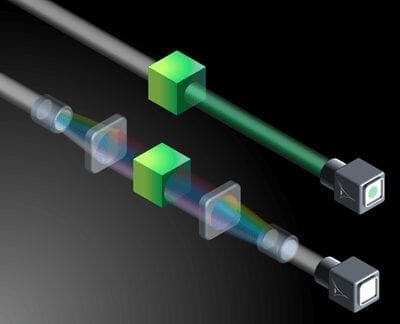
Image: Zhihao Jiang/Penn State
Developing the cloak of invisibility would be wonderful, but sometimes simply making an object appear to be something else will do the trick, according to Penn State electrical engineers.
“Previous attempts at cloaking using a single metasurface layer were restricted to very small-sized objects,” said Zhi Hao Jiang, postdoctoral fellow in electrical engineering, Penn State. “Also, the act of cloaking would prevent an enclosed antenna or sensor from communicating with the outside world.”
Jiang and Douglas H. Werner, John L. and Genevieve H. McCain Chair Professor of Electrical Engineering, developed a metamaterial coating with a negligible thickness that allows coated objects to function normally while appearing as something other than what they really are, or even completely disappearing. They report their research in Advanced Functional Materials.
The researchers employ what they call “illusion coatings,” coatings made up of a thin flexible substrate with copper patterns designed to create the desired result. They can take a practical size metal antenna or sensor, coat it with the patterned film and when the device is probed by a radio frequency source, the scattering signature of the enclosed object will appear to be that of a prescribed dielectric material like silicon or Teflon. Conversely, with the proper pattern, they can coat a dielectric and it will scatter electromagnetic waves the same as if it were a metal object.
“The demonstrated illusion/cloaking coating is a lightweight two-dimensional metasurface, not a bulky three-dimensional metamaterial,” said Werner.
The researchers take the object they want cloaked and surround it with a spacer, either air or foam. They then apply the ultrathin layer of dielectric with copper patterning designed for the wavelengths they wish to cloak. In this way, antennae and sensors could be made invisible or deceptive to remote inspection.
Another application of this material would be to protect objects from other emitting objects nearby while still allowing electromagnetic communication between them. This was not possible with the conventional transformation optics-based cloaking method because the cloaking mechanism electromagnetically blocked the cloaked object from the outside, but this new coating allows the object surrounded to continue working while being protected. In an array of antennae, for example, interference from the nearby antennas can be suppressed.
The Latest on: Illusion coatings
[google_news title=”” keyword=”Illusion coatings” num_posts=”10″ blurb_length=”0″ show_thumb=”left”]
via Google News
The Latest on: Illusion coatings
- 6 Paint Colors That Will Make Your House Sell for More Moneyon April 27, 2024 at 7:18 am
"When staging a home for sale, most guides will tell you to simply paint everything white, but luxury home buyers are looking for turnkey properties that look and feel designed, not institutional," ...
- What’s your favourite National Gallery painting? Our experts choose theirson April 26, 2024 at 9:00 am
David Hockney, Princess Eugenie, Grayson Perry, Rory Stewart and others on the artwork that means the most to them ...
- I'm an interior designer. I swear by these 10 tricks to make a room look bigger.on April 24, 2024 at 10:24 am
An interior designer shares decor and design tricks that make a small room feel bigger, from floor-to-ceiling curtains to translucent furniture.
- All of My Friends Have These Trompe l’oeil Sweatpant Jeanson April 24, 2024 at 8:14 am
A few months ago, my friend Danielle wore a pair of wide-leg jeans to a fundraiser we attended with our significant others. I immediately noticed the pants — I loved the wash and drape — but as I ...
- Art Seeks Enlightenment in Darknesson April 24, 2024 at 6:48 am
To enter Kehinde Wiley’s show “An Archaeology of Silence” is to step into darkness, where only the art itself seems to emit light. The space feels somewhere between a crypt and a cathedral, featuring ...
- Bradford-born artist's huge painting with an important messageon April 22, 2024 at 7:41 am
A former Bradford artist has created a giant anamorphic painting to encourage those voting in the 2024 General Election to think about climate.
- Microsoft Unveils VASA-1, An Eerily Realistic AI That Animates Still Portraitson April 19, 2024 at 7:44 am
Microsoft (Nasdaq: MSFT) has announced VASA-1, an AI system capable of bringing still images to life. The model uses a ...
- The Fallout Game You Need to Play While You Wait for Season 2 of the Showon April 16, 2024 at 11:21 am
With the full release of the Fallout show on Prime Video, revisit why Fallout: New Vegas is some of the series' best ever writing, especially with its possible connections to a potential Season 2.
- How CMOs Should Embrace Authenticity In Hispanic Marketing Beyond Latino Coatingon April 16, 2024 at 9:00 am
Amidst the vibrant tapestry of cultures, there lies a prevalent issue that often goes unnoticed - Latino Coating. What exactly is Latino Coating?
- The 6 things I wish I knew before painting the ceilings in my homeon April 15, 2024 at 8:01 am
People tell you adding color to the fifth wall in your space will add drama and draw the eye up, creating the illusion of space and making small offices look bigger — but they don't tell you ...
via Bing News










